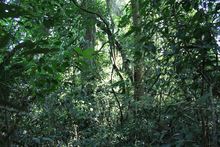JYOTI SHETTY and NALA PONNAPPA experience the sacred forest of Kodagu
and come back wiser
Walking along the edge of the Devara Kaadu, the sacred forest dedicated
to goddess Bhagawati in Karada village, Kodagu, we were searching for a path to
get into the forest. Tucked away in a corner and spread over nine acres, rarely
has anyone entered the hallowed precincts of this sacred grove. Yet, we were
there looking for a small clearing and were relieved to find one.
We walked slowly over a thick carpet of dead leaves, tapping our walking
sticks intermittently for any wayward snake or insect. Then we came to a
grinding halt. The clearing did not go deep enough; we had to take another path
to move ahead.
All along, the intertwining vines formed a curtain, snaking high up. To
part these or even break a twig is considered sacrilegious. No wonder, as no
paths were cut through the jungle, vines grew all over just like cobwebs.
Ancient groves like these are deeply revered by the local communities.
The groves, which are hubs of biodiversity, are found largely in Karnataka’s
Kodagu, or Coorg region. For the nature-loving Kodava community, Devara Kaadu
is a place of worship to appease its favourite deities. Over a hundred years
ago, there were more than a 1,000 such sacred groves in the region. Now there
are only 350 left.
We stopped by an old tree to catch our breath. We found the peace and
quiet overpowering. We had entered into the realms of an authentic untouched
forest, most revered by the Kodavas. Not even cows graze here. Were we
trespassing? What if the gods get angry?
Forest Deities
With so many questions welling up in our minds, we moved on. There is
not much of wildlife here. The tigers, wild dogs and flying squirrels are all
long gone; wild boars can be sighted occasionally but then it’s the Kodavas’
favourite dish. Then what was it about the forest that looked so intimidating?
Was it the myth and stories that floated around these dark, eerie forests
working on our minds?
The screen of lush vegetation all around was very appeasing, but the
crunching leaves below were not. We kept an eye out for any camouflaged insects
and reptiles. Stepping on dead wood was equally dangerous; being hollow, they
crumble when you step on them.
At last we reached a sunlight-drenched clearing from where a path led to
the Bhagawati Temple; the sunlight lifted our spirits and reassured us.
The priest was not very welcoming though. His apprehension was
understandable. He did not want too many inquisitive travellers disturbing the
peace of the forest.
Most villages in Coorg have temples dedicated to deities such as Devi
Bhadrakali, Aiyyappa, Shiva or Iguthappa. These places of worship double up as
venues for numerous religious functions and celebrations, with the sacred
groves forming an impressive backdrop, changing colours with the season.
Sometimes new leaves on the huge trees look like red and yellow festoons,
fluttering away in the gentle breeze as if celebrating deep forest secrets.
Villagers were allowed to take wood and any edible fruits only from the
fringes; even today, the heart of the Devara Kaadu is untouched, unspoilt, and
pristine.
Sacred groves are an integral part of the shrines to which they are
attached. In every village, the sacred grove exists because of the temple.
The size of the sacred grove is not important; the world has a lot to
learn from the tradition of forest conservation that every village in Kodagu
upholds. Each grove has three common features: the deity, the temple forest and
the sacred tank. Tree diversity is high in these groves. Whoever said
conservation of forest began in the 21st century?
Myths To The Rescue
In and around our village, there are two prominent groves besides the
one we entered — in Kadanga near the Arupatt Temple and a smaller grove near
the Ishwara Temple in Chelavara.
The forests regenerate, thrive, and live entirely as nature deems fit.
The weak trees rot and fall, making way for new growth, allowing sunlight to
penetrate and provide succour from the dark covers of tall overgrowth and
much-needed compost. Some of the deadwood is used to renovate the temples.
The core of the Devara Kaadu remains untouched, and even the temple
priests don’t venture deep inside. During the Boluk Namme or Festival of
Lights, an annual ceremony held in April, the entire village congregates;
chicken is sacrificed at the edge of the forest to appease the resident gods.
However, over time, mankind multiplied faster than the forest growth and
maintaining the eco system became a big challenge. To curtail land-grabbing,
the priests came up with myths and legends. The locals believe that the gods
hunt in these forests and some even say that the spirits of their ancestors
rest in the woods.
If we can take a leaf out of the Devara Kaadu, there is so much to
learn. We can peep into the original terrain and gain insight into what the
landscape must have been in ancient times. Sadly, commercialisation, in the
form of coffee plantations, hotels and homes has not spared even these revered
forests.
To educate the future generation on the importance of forests and tell
them about the symbiotic relationship that exists between the groves and
mankind, this slice of Kodava culture has to be preserved and conserved. We
have to venerate the gods and spirits of the forests, so that they protect us.
After all, the tradition of tree worship has its roots in the vedas, where the
ficus tree has been described as housing the fertility spirits of the mythical
gandharvas and apsaras.
ponnappa48@gmail.com

No comments:
Post a Comment